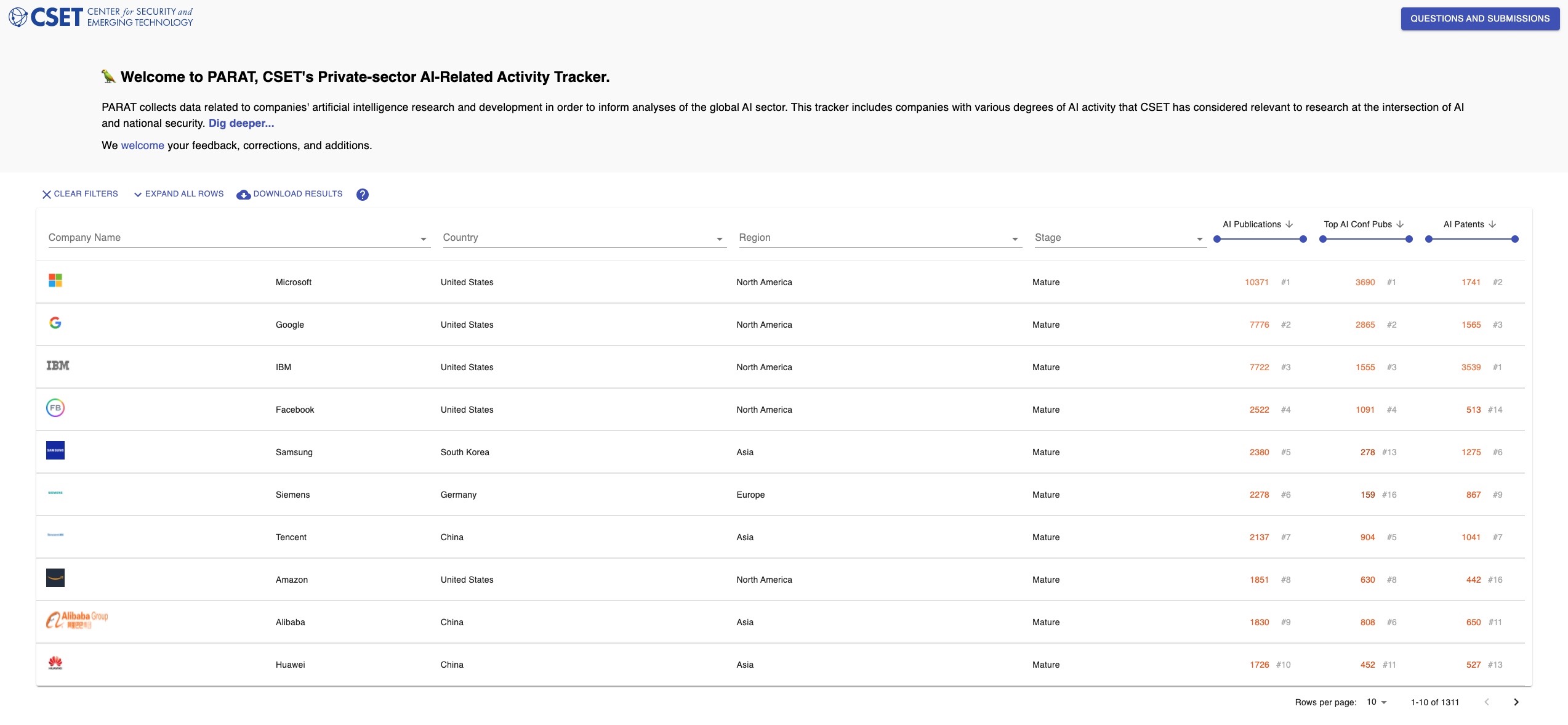As discussed in “Exploring CSET’s PARAT,” CSET’s Private-sector AI-Related Activity Tracker displays aggregated data on companies’ AI research and development, with metrics such as AI Publications, Top Conference AI Publications, and AI Patents. In this snapshot, we investigate the difference in company rankings when we switch from overall AI publications to publications at top AI conferences.1
The five companies in PARAT with the most AI publications are Microsoft, Google, IBM, Facebook, and Samsung, respectively (shown in Table 1). In order to assess which companies have a significant share of their AI research output published in top conferences, we rank companies in a different way: by their relative output of top AI conference publications. This provides insight into the type of AI research a company is producing, since top AI conferences are selective, well-respected venues that publish peer-reviewed research.
To calculate a company’s relative output of top AI conference publications, we divided the company’s number of top AI conference publications by their number of total AI publications, of any type. This results in the percentage of that company’s AI research that is published in top AI conferences.2
Ranking companies in PARAT by this measure, we see a different top five emerge: LinkedIn, Spotify, Verizon, Twitter, and SenseTime (shown in Table 2). This new ranking allows us to identify companies with a high share of their AI research being published at top AI conferences. Tables 1 and 2 provide company rankings by both measures, and report the percentage of AI publications in top AI conferences for the 10 companies discussed above. We see significant ranking shifts for Samsung (#5 to #61), Linkedin (#89 to #1), Spotify (#104 to #2), and Twitter (#67 to #4), with ranking differences larger than 50 spots.
Table 1. Top five companies by AI publications
| Company | Country | Ranking by AI Publications | Ranking by Top AI Conference Publications | % AI Publications that are Top AI Conference Publications |
| Microsoft | 🇺🇸 United States | #1 | #13 | 45% |
| 🇺🇸 United States | #2 | #22 | 39% | |
| IBM | 🇺🇸 United States | #3 | #32 | 29% |
| 🇺🇸 United States | #4 | #15 | 43% | |
| Samsung | 🇰🇷 South Korea | #5 | #61 | 12% |
Table 2. Top five companies by percentage of AI publications that are top AI conference publications
| Company | Country | Ranking by AI Publications | Ranking by Top AI Conference Publications | % AI Publications that are Top AI Conference Publications |
| 🇺🇸 United States | #89 | #1 | 92% | |
| Spotify | 🇸🇪 Sweden | #104 | #2 | 78% |
| Verizon | 🇺🇸 United States | #13 | #3 | 75% |
| 🇺🇸 United States | #67 | #4 | 57% | |
| SenseTime | 🇨🇳 China | #24 | #5 | 56% |
Next, we look at the trends in these companies’ top AI conference publications from 2010 to 2020 in order to explore changes in publication counts. Figure 1 displays the absolute number of top AI conference publications for the top five companies by overall AI publication output (Microsoft, Google, IBM, Facebook, and Samsung). Figure 2 displays the results for the top five companies ranked by percentage of AI publications that are top AI conference publications (LinkedIn, Spotify, Verizon, Twitter, and SenseTime).
Figure 1. Number of top AI conference publications by company between 2010 and 2020
As shown in Figure 1, Microsoft led in sheer number of top AI conference publications until 2018, when Google took the lead. In 2020, Google published 656 top AI conference publications, with Microsoft publishing 535, Facebook publishing 258, IBM publishing 256, and Samsung publishing 75.
Figure 2. Number of top AI conference publications by company between 2010 and 2020
Figure 2 shows that Verizon led the top five companies according to percentage of AI publications that are top AI conference publications until 2018, when SenseTime took the lead. In 2020, SenseTime published 110 top AI conference publications, with Verizon publishing 21, Spotify publishing 14, Twitter publishing nine, and LinkedIn publishing eight.
There is a noticeable scale difference in the number of top AI conference publications between the top five companies based on overall AI publications and the top five companies based on percentage of publications in top AI conferences. For example, in 2020 LinkedIn had eight top AI conference publications, while Samsung had 75. However, those eight publications represent a much larger share (80 percent) of LinkedIn’s AI publications that year, compared to Samsung’s 75 publications, which represent a smaller share (19 percent) of its AI publications that year.
This analysis looked into the difference in top companies based on a different ranking metric: percentage of AI publications that are top AI conference publications. In the next data snapshot we will dive deeper into where companies are publishing their top AI conference publications.
- Top 13 AI conferences based on CSRankings are AAAI Conference on Artificial Intelligence (AAAI), International Joint Conference on Artificial Intelligence (IJCAI), IEEE Conference on Computer Vision and Pattern Recognition (CVPR), European Conference on Computer Vision (ECCV), IEEE International Conference on Computer Vision (ICCV), International Conference on Machine Learning (ICML), International Conference on Knowledge Discovery Data Mining (SIGKDD), Conference on Neural Information Processing Systems (NeurIPS), Annual Meeting of the Association for Computational Linguistics (ACL), North American Chapter of the Association for Computational Linguistics (NAACL), Conference on Empirical Methods in Natural Language Processing (EMNLP), International Conference on Research and Development in Information Retrieval (SIGIR), and the Web Conference (WWW)
- We filter out 18 companies that have five or less AI research publications total, with all AI publications being published in top AI conferences. While they have 100 percent of their AI publications in top conferences, their total AI research output is extremely low.
